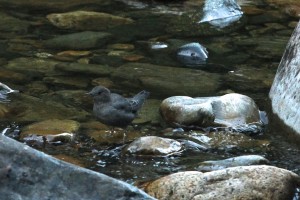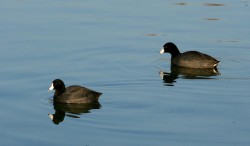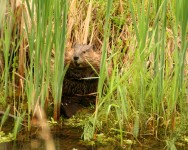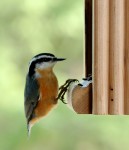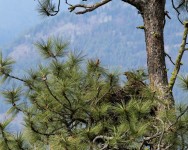Standing on an almost-submerged rock in the mountain stream, the chunky gray bird waded into the fast-flowing water and stuck its head underwater. Snorkeling, the bird made its way to another rock downstream.
As North America’s only aquatic songbird, the American Dipper has filled a niche left open by other songbirds. While most songbirds stop at the water’s edge, the dipper capitalizes on the aquatic insects within mountain streams.
The dipper can skim the water for insects or search underwater, even turning over small stones, to find food. They also easily catch insects in mid-air. Dippers forage for aquatic larvae of mayflies, mosquitoes and caddisflies, along with dragonflies, worms, small fish, fish eggs and tadpoles. During insect hatches, they often fly just above the water’s surface to catch the swarming insects.
Many adaptations allow the dipper to thrive in cold, swift streams. Nostril flaps prevent water from entering the nasal passages when snorkeling or swimming. A third eyelid acts as a windshield wiper when underwater–they can remain submerged for 15 to 30 seconds. With a high amount of hemoglobin in their blood, dippers possess the greatest oxygen capacity of any songbird.
Dippers counteract their natural buoyancy by “flying” underwater with powerful strokes from their short wings and paddling with their feet. They also use their strong toes to grasp rocks below and above water.
A dense coat of feathers insulates the dipper from the cold water year round. On average, a dipper has 4,200 feathers compared to a robin’s 3,000 feathers. A thick layer of down feathers is protected by a dense layer of waterproofed contour feathers.
Dippers maintain the waterproofing by preening extensively to spread the waterproofing oils over all their feathers. Compared to other songbirds, the preen gland containing the waterproofing oils is 10 times larger for dippers.
The waterproof oil and thick down coat are essential to a bird that doesn’t migrate south for the winter. Instead, the dipper seeks patches of open water to forage, whether a hole in the ice near rapids or where two streams meet. With an efficient internal system of thermoregulation, the dipper survives winter as far north as the Brooks Range in Alaska.
Even above the babbling sound of mountain streams, the dipper can be heard singing its sweet, bell-tone. Both males and females can sing for 10 minutes straight.
As the name implies, the dipper is also known for its habit of dipping or bobbing while perched on a rock or ledge. The reason for this behavior is unknown but scientists think the behavior may help in visual communication, predator concealment or in spotting prey.
The gray dipper blends in well with the earthen-tone rocks of the streams and it creates a nest even more camouflaged. The volleyball-sized nest is covered in an outer shell of moss. Unlike other songbirds who build an open-cup nest, the dipper builds an enclosed ball with a side opening to prevent stream-side water spray from entering the nest.
The nests are built on cliff ledges, caves in boulder piles, dams and bridges. The life-long pair returns to the same nest every year. After nesting is completed, the pair removes the dried grass lining of the nest in preparation for the next brood.
When leaving the nest, the fledgings readily swim to begin their lives among the rocky boulders of mountain streams where competition is scarce.

